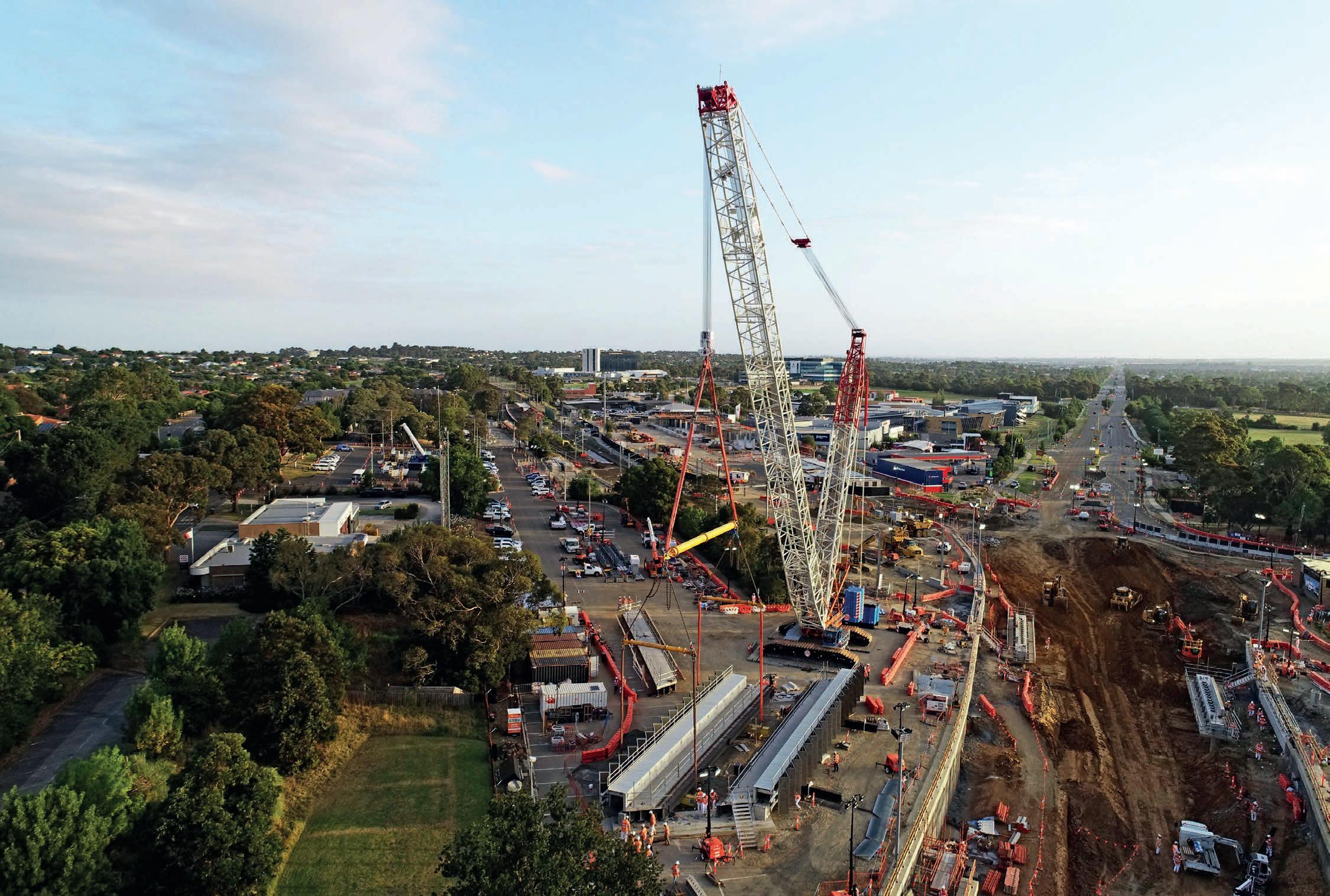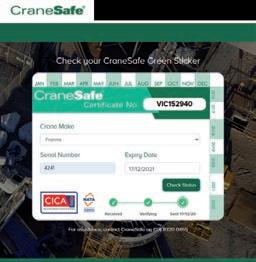
7 minute read
JV boosts heavy lifting capacity
JOINT VENTURE TO BOOST HEAVY LIFTING CAPACITY FOR JOHNSON AND YOUNG CRANES AND MCKAY UNITED
Johnson & Young Cranes along with McKay United have begun a joint venture centred around the crossover ownership of the only three Tadano CC2200s in Australia.
THE VICTORIAN COMPANIES NOTICED A
gap in the market for these larger capacity machines and created the JYM brand. The joint venture also purchased two Tadano CC3800s with full SSL, boom boost, and split tray capabilities to allow JYM to focus on the heavy lift operations.
The joint venture sees the two parent companies focusing on two separate markets. Johnson & Young Cranes is focusing on large civil infrastructure projects and McKay United is continuing to focus on refinery and port operations.
The crawler cranes allow the JYM team the capability to lift an impressive weight, far exceeding that of the all terrains.
The focus of each ensures the joint venture can maximise the use of its fleet and opportunities are magnified.
Ben Musson is the heavy lift manager at Johnson Young Mackay and is happy with the performance of the two crawler cranes from Tadano.
“McKay purchased both of their CC2200 units in April and November 2017, respectively, with the purchase of the JYC machine coming in April 2019. The first CC3800 arrived in February of 2021 and JYM was born from that,” Musson said.
The newly formed JYM fleet is made up of three Demag CC2200s and two CC3800s. The McKay fleet consists of several all terrain units ranging from 16 tonnes to 220 tonnes and the JYC fleet has numerous Tadano bubbles.
Heavy lifting is in Johnson & Young Crane’s DNA and it is continuing to grow, preparing for new additions to its crane fleet.
“The all terrain machines are fantastic pieces of kit. They provide a number of advantages including quick set up times and smaller mobilisation costs, but from a capacity point of view the crawlers will always take the crown,” Musson said.
The crawler cranes gives the JYM team the capability to lift an impressive weight, far exceeding that of the all terrains.
“The all terrain units are generally mobilised for quick assembly in tight spots with loads up to 150t with a smaller radius or windfarm maintenance work. By comparison, the CC3800 can lift in excess of 550t at the same radius, or 150t at 50m radius, it’s really horses for courses, but sometimes only a crawler will do,” Musson said.
“The crawlers really come into their own on time critical jobs where there are short windows of opportunity which need to be used with maximum efficiency, such as road and rail closures or plant shutdowns.
“With the use of the heavy lift crawlers, it is possible to modularise components of a plant or structure into far larger and heavier components, which reduces downtime and increases efficiency, and, more importantly,

With the use of the heavy lift crawlers, it is possible to modularise components of a plant or structure into far larger and heavier components, which reduces downtime and increases efficiency.

client satisfaction. Lifts are changing as the industry evolves. When you think back, a bridge construction involved 8 or 10 beam lifts and there would be a deck pour and parapet installation. Today, there are one or two single structure lifts with the deck already poured and parapets already attached,” Musson said.
The new Tadano CC3800 has been an asset for JYM when completing a number of impressive lifts as a part of Victoria’s big build projects including a level crossing removal for Fulton Hogan at Clyde Road.
“We were able to add some additional intermediate deck girders to the original design of the deck modules, which reduced the number of lifts and, more importantly, the bolting of bracings could be performed at ground level. By doing this at ground level we were able to remove the working at height risk and keep other operations productive on the new road alignment. Previously, an exclusion zone would have had to have been in place,” Musson said.
“The addition of the girders to the deck modules also removed some potential clash issues with the reinforcement starter bars which interacted during the install, saving time on the program during the occupation. This was only possible with the additional capacity the CC3800 provided,” Musson said.
Operating some of the more unique cranes within Australia poses challenges to the JYM team when planning a lift, but clear communication with clients ensures the most efficient lift is completed.
“The best outcomes are generally
achieved when we have early engagement from the client during the initial design phase, this provides the team with an opportunity to demonstrate the capabilities of the cranes, which may not always be apparent to the client’s design team.
“Often this leads to the opportunity to reduce the number of modules in a structure, which obviously reduces the time required for a road or rail occupation and the site team can perform the construction in a safer, more controlled environment,” Musson said.
“With the CC3800s in particular, these models are relatively new to Victoria and even the Australian market, the machines have far more versatile capabilities with the Vario mast super lift, flex frame, boom booster and split tray than their CC2800 predecessor,” Musson said.
“Clients are not always aware of the advantages these options can provide, so our early engagement always produces further positive outcomes in design and the subsequent delivery phase of a project.
“I myself am currently working closely on permanent basis with the West Gate Tunnel Project steel installation team on behalf of JYC, to ensure all the advantages of the CC3800 configurations are utilised by the team.
“Both JYC and Mckay United have excellent engineering capabilities within their respective teams. Depending on the complexity of the operation, JYM, through the parent companies, have the in-house ability to provide detailed 3D lift plans, 3D rigging arrangements and even 3D
animation to identify any potential issues or clashes.
“We can essentially simulate the entire operation prior to the crane even arriving on site. In the case of the Clyde Road project, the addition of the girders changed the CoG [centre of gravity] of the deck modules. Working closely with the Fulton Hogan Engineers and their partners, along with Edwards Heavy Lift, we were able to design a suitable rigging arrangement to make the changes possible and ensure the load was stable and level at all stages to guarantee a smooth installation during the time critical occupation.
“To speed up the install time, we worked closely with the client to
The new Tadano CC3800s have been an asset for JYM completing a number of impressive lifts as a part of Victoria’s big build projects, including a level crossing removal for Fulton Hogan at Clyde Road.
plan the preassembly location of the deck modules and transport delivery location of the precast elements, so that all lifts, notwithstanding the first deck module, could be picked without the requirement of the SL tray.
“This removed the need to relocate the SL CW between lifts, massively increasing productivity. All lifts were in excess of 90t with a max radius of 50m with deck modules just a touch under 110t.
“The CC3800 was set up in the SSL1 configuration with a 60m boom and made light work of these lifts. 165t of the 225t superstructure counterweight, 165t of the 325t super-lift counterweight and 13.5m of the 21.5m super-lift mast radius was required to maintain all lifts under 90 per cent of crane capacity.
“The Vario SL also assists greatly with ensuring that 90 per cent of capacity is not exceeded, which is often a client requirement. Many older crawler models only have the capability to have a set SL radius which cannot be adjusted during the lift – the CC3800 has the ability to fine tune the SL radius to any position while remaining within the capacity chart. This is also advantageous when trying to negotiate the tray and mast past obstacles or in tight set up locations.
“Though the non-Vario SL PLMIN charts on older machines generally have some crossover, the versatility of the Vario mast ensures the tray can float with almost any load and, in most cases, remain under the 90 per cent capacity threshold,” he said.

6 Reasons to choose CraneSafe

1. Complies with Australian Standard
recommendations
Supported by major crane manufacturers
Accepted by all State OH&S departments
Only NATA accredited crane inspection
program
Nationally recognised by the CFMEU
Assessors are independently audited

Industry-led Independent Inspections












